
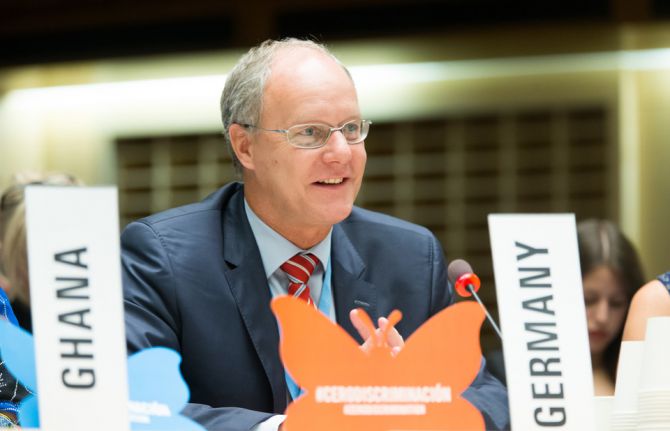

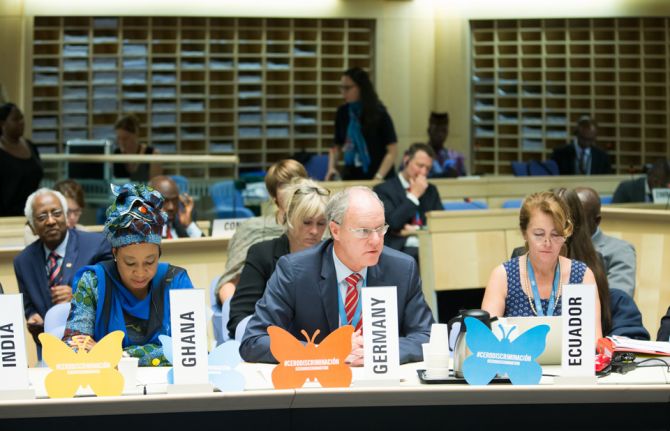
Press Release
Germany to double contributions to UNAIDS
27 June 2017 27 June 2017GENEVA, 27 June 2017—The Government of Germany has announced that it will double its funding to UNAIDS in 2017-2018, to €5 million per year. Germany made the announcement at the 40th Meeting of the UNAIDS Programme Coordinating Board, being held in Geneva, Switzerland.
“With Germany, we have a common goal of ending AIDS and a shared commitment to strengthen health systems and improve the health and well-being of people across the world,” said Michel Sidibé, Executive Director of UNAIDS. “We warmly welcome Germany’s support and its recognition of the important role that UNAIDS plays in ending AIDS and in broader global health and development efforts.”
“UNAIDS is an important partner for Germany’s health and development agenda, particularly in Africa. Increased investment in UNAIDS and the AIDS response will have a multiplier effect on the wider Sustainable Development Goal agenda,” highlighted Gerd Müller, Federal Minister of Economic Cooperation and Development, Germany.
Germany has prioritized health on the global development agenda and under its current Presidency of the Group of Twenty (G20) held the first ever G20 health ministers meeting in May 2017.
“Ending AIDS is a historic goal and I firmly believe we can reach it. We have to increase our joint efforts and UNAIDS is central to that work,” said Hermann Gröhe, Federal Minister of Health, Germany.
UNAIDS
The Joint United Nations Programme on HIV/AIDS (UNAIDS) leads and inspires the world to achieve its shared vision of zero new HIV infections, zero discrimination and zero AIDS-related deaths. UNAIDS unites the efforts of 11 UN organizations—UNHCR, UNICEF, WFP, UNDP, UNFPA, UNODC, UN Women, ILO, UNESCO, WHO and the World Bank—and works closely with global and national partners towards ending the AIDS epidemic by 2030 as part of the Sustainable Development Goals. Learn more at unaids.org and connect with us on Facebook, Twitter, Instagram and YouTube.

Press Release
UNAIDS gala sees art and design world come together to raise awareness and support for UNAIDS’ efforts to end AIDS by 2030
13 June 2017 13 June 2017Evening hosted by Her Royal Highness Princess Eugenie of York, Caroline Rupert and Ndaba Mandela. Guests paid tribute to the legacy of AIDS activist Dame Elizabeth Taylor and enjoyed star performances by Nico & Vinz and live auction by auctioneer Simon de Pury
BASEL/GENEVA, 13 June 2017—Supporters of UNAIDS attended its annual gala on 12 June, hosted by Her Royal Highness Princess Eugenie of York, Caroline Rupert and Nelson Mandela’s grandson, Ndaba Mandela. Held at Design Miami/Basel on the eve of the Art Basel art festival, the guests pledged their support to the work of UNAIDS in increasing access to HIV prevention and treatment services worldwide.
“We have come a very long way in responding to HIV and millions of lives have been saved, but AIDS is not over. Every hour 125 people die of AIDS and 240 people are newly infected with HIV,” said Michel Sidibé, Executive Director of UNAIDS. “As Dame Elizabeth Taylor said, we must “win for all humanity”. Leave this gala with her sense of urgency, her compassion and commitment. Because together we can reach our dream of ending AIDS.”
The hosts welcomed around 270 international guests from the worlds of art, design, architecture, fashion, film and music. The gala was made possible by Cartier and the hotel InterContinental Geneva, with the support of Design Miami/.
The evening honoured the legacy of longstanding AIDS activist Dame Elizabeth Taylor, whose grandson Quinn Tivey was present at the gala. A special tribute was held in recognition of Dame Elizabeth’s remarkable contributions to improving the lives of people living with HIV.
The evening began with an exclusive vernissage of Design Miami/Basel, showcasing work from some of the world’s most important collectible designers of the 20th and 21st centuries.
After the reception and preview, Her Royal Highness Princess Eugenie of York and Caroline Rupert welcomed the guests. Auctioneer Simon de Pury then opened a live auction, with lots from designers that included Catherine Opie, Cartier, Dustin Yellin, the Haas Brothers and Pierre Jeanneret.
The gala concluded with a special live musical performance by Nico & Vinz, who entertained guests with new releases as well as popular hits, such as Am I Wrong? DJ Bas Ibellini took to the stage for the after-party to close the evening.
Website and social
#AIDSisnotover #UNAIDSgala
Instagram: @unaidsglobal
Facebook: facebook.com/UNAIDS
Twitter: twitter.com/unaids
Media contacts
UNAIDS | Sophie Barton-Knott | tel. +41 22 791 1697 | bartonknotts@unaids.org
Camron PR | Hannah Perry | Hannah.Perry@camronpr.com
Camron PR | Max Tobias | Max.Tobias@camronpr.com
UNAIDS
The Joint United Nations Programme on HIV/AIDS (UNAIDS) leads and inspires the world to achieve its shared vision of zero new HIV infections, zero discrimination and zero AIDS-related deaths. UNAIDS unites the efforts of 11 UN organizations—UNHCR, UNICEF, WFP, UNDP, UNFPA, UNODC, UN Women, ILO, UNESCO, WHO and the World Bank—and works closely with global and national partners towards ending the AIDS epidemic by 2030 as part of the Sustainable Development Goals. Learn more at unaids.org and connect with us on Facebook, Twitter, Instagram and YouTube.
InterContinental Geneva Hotel
The hotel opened its doors in 1964 and was renovated by world famous designer Tony Chi. Its legendary discretion and security have made it the confidant and caretaker of many events of international importance. The Residence on the top floor is the highest and most prestigious Suite in Geneva and offers a breathtaking 360° view of the mountains, the lake, the city and its spectacular setting (1'000 sqm). Lying at the heart of the diplomatic district, the hotel turns into a relaxing destination during the summer, featuring the largest outdoor swimming pool in Geneva. In 2013, the hotel and UNAIDS entered into a public–private partnership inviting guests to “make history” and pledge for an AIDS-free generation. www.geneva-intercontinental.com
Design Miami/
Design Miami/ is the global forum for design. Each fair brings together the most influential collectors, gallerists, designers, curators and critics from around the world in celebration of design culture and commerce. Occurring alongside the Art Basel fairs in Miami, United States of America, each December and Basel, Switzerland, each June, Design Miami/ has become the premier venue for collecting, exhibiting, discussing and creating collectible design.
www.designmiami.com
Cartier
The Cartier Charitable Foundation was established in 2012 to catalyse the Maison Cartier’s philanthropic commitment to improve the livelihoods of the most vulnerable. The foundation focuses on the most excluded and marginalized, in particular women and children living in the world’s least developed regions. Its efforts seek to remove the barriers that prevent people from acting and thriving, enabling them to live a meaningful and fulfilling life in an inclusive, equitable and safe environment. The foundation currently supports 20 partners in 30 developing countries. For additional information, please visit http://www.cartiercharitablefoundation.org/en
Contact
UNAIDSSophie Barton-Knott
tel. +41 22 791 1697
bartonknotts@unaids.org
Camron PR
Hannah Perry
Hannah.Perry@camronpr.com
Camron PR
Max Tobias
Max.Tobias@camronpr.com
Press centre
Download the printable version (PDF)

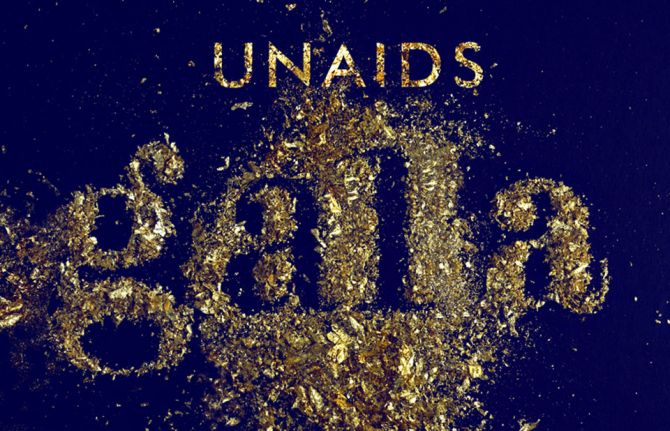
Press Release
UNAIDS gala returns to Basel in June to raise awareness and funds to support efforts to end AIDS by 2030
06 June 2017 06 June 2017Second UNAIDS gala to be hosted by Her Royal Highness Princess Eugenie of York, Caroline Rupert and Ndaba Mandela
Auctioneer Simon de Pury to run the live auction, featuring one-of-a-kind art and design pieces
BASEL/GENEVA, 06 June 2017—UNAIDS, in collaboration with Cartier, the InterContinental Geneva Hotel and Design Miami/, is to host its second fundraising dinner and auction to mark the start of Art Basel and Design Miami/ Basel on Monday, 12 June, in Hall 1 Sud at the Messeplatz. The event aims to raise much needed funds to support UNAIDS’ work in ensuring access to HIV prevention and treatment services worldwide.
There were more than 36 million people living with HIV in 2015. To survive and thrive, everyone living with HIV needs immediate access to treatment, yet only half have access to life-saving medicines and around 40% of people living with HIV don’t even know they have the virus. UNAIDS is working to ensure that people can get tested for HIV and access treatment and care if they test positive.
New HIV infections are still occurring at an alarmingly high rate. Around 2 million people became infected with HIV in 2015. UNAIDS is working hard to reach the populations most affected by HIV and make sure they have the tools to protect themselves against the virus.
THE GALA
The gala will be hosted by Her Royal Highness Princess Eugenie of York, Caroline Rupert and Nelson Mandela’s grandson, Ndaba Mandela, who will welcome international guests from the worlds of art, design, architecture, fashion, film and music.
The evening will honour the legacy of longstanding AIDS activist Dame Elizabeth Taylor, and include a live auction run by Simon de Pury, with rare and one-of a kind art and design lots from the Haas Brothers, Cartier, Catherine Opie, Dustin Yellin and Pierre Jeanneret.
Beginning with the invitation-only vernissage of Design Miami/ Basel, guests will enjoy a private reception and preview, showcasing work from some of the world’s most important collectible design galleries of the 20th and 21st centuries. Other highlights of the gala include a performance by long-time UNAIDS supporters Nico & Vinz, a silent auction and an after-party hosted by DJ Bas Ibellini.
“We are pleased that the UNAIDS gala will be returning to Art Basel for the second year,” said Michel Sidibé, Executive Director of UNAIDS. “Last year was a fantastic success and we look forward to using this unique platform to continue our endeavour to make history and end the AIDS epidemic, ensuring that no one is left behind or excluded from life-saving HIV services.”
The event is being generously supported Cartier, the InterContinental Geneva Hotel and Design Miami/. Tickets are available at https://www.universe.com/events/unaids-gala-tickets-5KZTDQ at CHF 750 for an individual ticket, with tables of 10 starting at CHF 7000.
Featured lots include:
- Catherine Opie— Jewels in Afternoon Light #3 on behalf of the Elizabeth Taylor AIDS Foundation
- Cartier—bespoke Juste un Clou bracelet specifically designed for UNAIDS
- Dustin Yellin—Procession from Under the Sea sculpture
- Haas Brothers— Unique Dick Drake Mini Beast unique piece, in Brown Icelandic sheepskin with cast bronze Large Mouth, Large Erect Dong, and Short Pickle Feet
- Pierre Jeanneret —“Office” Chair
- John M. Armleder — DORAYAKI N2, Mirror, iridescent blown glass Limited Edition of 5
- InterContinental — The InterContinental European Experience
- Sam Orlando Miller — Untitled Mirror 1 (Sky Blue)
- FOS — Street Lamp
For media information and press registration please contact
Camron PR
Hannah Perry / Hannah.Perry@camronpr.com
Max Tobias / Max.Tobias@camronpr.com
Website and social
#AIDSisnotover #UNAIDSgala
Instagram: @unaidsglobal
Facebook: facebook.com/UNAIDS
Twitter: twitter.com/unaids
UNAIDS
The Joint United Nations Programme on HIV/AIDS (UNAIDS) leads and inspires the world to achieve its shared vision of zero new HIV infections, zero discrimination and zero AIDS-related deaths. UNAIDS unites the efforts of 11 UN organizations—UNHCR, UNICEF, WFP, UNDP, UNFPA, UNODC, UN Women, ILO, UNESCO, WHO and the World Bank—and works closely with global and national partners towards ending the AIDS epidemic by 2030 as part of the Sustainable Development Goals. Learn more at unaids.org and connect with us on Facebook, Twitter, Instagram and YouTube.
Cartier
The Cartier Charitable Foundation was established in 2012 to catalyse the Maison Cartier’s philanthropic commitment to improve the livelihoods of the most vulnerable. The foundation focuses on the most excluded and marginalized, in particular women and children living in the world’s least developed regions. Its efforts seek to remove the barriers that prevent people from acting and thriving, enabling them to live a meaningful and fulfilling life in an inclusive, equitable and safe environment. The foundation currently supports 20 partners in 30 developing countries. For additional information, please visit http://www.cartiercharitablefoundation.org/en
InterContinental Geneva Hotel
The hotel opened its doors in 1964 and was renovated by world famous designer Tony Chi.
Its legendary discretion and security have made it the confidant and caretaker of many events of international importance. The Residence on the top floor is the highest and most prestigious Suite in Geneva and offers a breathtaking 360° view of the mountains, the lake, the city and its spectacular setting (1'000 sqm). Lying at the heart of the diplomatic district, the hotel turns into a relaxing destination during the summer, featuring the largest outdoor swimming pool in Geneva. In 2013, the hotel and UNAIDS entered into a public–private partnership inviting guests to “make history” and pledge for an AIDS-free generation. www.geneva-intercontinental.com
Design Miami/
Design Miami/ is the global forum for design. Each fair brings together the most influential collectors, gallerists, designers, curators and critics from around the world in celebration of design culture and commerce. Occurring alongside the Art Basel fairs in Miami, United States of America, each December and Basel, Switzerland, each June, Design Miami/ has become the premier venue for collecting, exhibiting, discussing and creating collectible design. For more information, please visit www.designmiami.com
Production
Josh Wood Productions
Contact
Media information and press registrationHannah Perry
Hannah.Perry@camronpr.com
Media information and press registration
Max Tobias
Max.Tobias@camronpr.com
Ticket office
Press centre
Download the printable version (PDF)


Press Release
UNAIDS warns that countries will miss the 2020 target of reducing HIV-associated TB deaths by 75% unless urgent action is taken
23 March 2017 23 March 2017GENEVA, 24 March 2017—On World Tuberculosis Day, 24 March, UNAIDS is urging countries to do much more to reduce the number of tuberculosis (TB) deaths among people living with HIV. TB is the most common cause of hospital admission and death among people living with HIV. In 2015, 1.1 million people died from an AIDS-related illness—around 400 000 of whom died from TB, including 40 000 children.
“It is unacceptable that so many people living with HIV die from tuberculosis, and that most are undiagnosed or untreated,” said Michel Sidibé, Executive Director of UNAIDS. “Only by stepping up collaboration between HIV and tuberculosis programmes to accelerate joint action can the world reach its critical HIV and tuberculosis targets.”
Eight countries—the Democratic Republic of the Congo, India, Indonesia, Mozambique, Nigeria, South Africa, the United Republic of Tanzania and Zambia—account for around 70% of all TB deaths among people living with HIV. Scaling up action in these eight countries would put the world on track to reach the ambitious target in the 2016 United Nations Political Declaration on Ending AIDS of reducing TB-related deaths among people living with HIV by 75% by 2020.
Weaknesses in health systems are continuing to result in missed opportunities to diagnose TB among people living with HIV—around 57% of HIV-associated TB cases remained untreated in 2015. Inadequate linkages to care after diagnosis, poor tracking of people and loss to follow-up, failure to reach the people most at risk of disease—particularly marginalized populations, including people who inject drugs, prisoners and migrant workers—and poor treatment outcomes contribute to the lack of progress. In 2014, around 11% of HIV-positive TB patients died, compared with 3% of HIV-negative TB patients. Early detection and effective treatment are essential to prevent TB-associated deaths, especially among people living with HIV.
Drug resistance is also a major concern—in 2015, there were an estimated 480 000 new cases of multidrug-resistant TB. The recent approval of two new medicines to treat TB, the first in more than 60 years, is improving the outlook for people with drug-resistant TB.
UNAIDS calls for the elimination of TB deaths among people living with HIV and for health systems to be strengthened and services integrated to allow for a more rapid scale-up of HIV and TB programming. Countries must expand HIV prevention and treatment programmes that include regular TB screening, preventive therapy and early treatment, since they are simple, affordable and effective programmes that prevent TB deaths.
UNAIDS is continuing to support countries to Fast-Track their efforts to reach the critical 2020 targets of the 2016 Political Declaration. As part of these efforts, UNAIDS is urging countries to intensify action in 35 high-priority countries to accelerate results by implementing focused, high-impact programmes to advance progress in ending the AIDS epidemic.
UNAIDS
The Joint United Nations Programme on HIV/AIDS (UNAIDS) leads and inspires the world to achieve its shared vision of zero new HIV infections, zero discrimination and zero AIDS-related deaths. UNAIDS unites the efforts of 11 UN organizations—UNHCR, UNICEF, WFP, UNDP, UNFPA, UNODC, UN Women, ILO, UNESCO, WHO and the World Bank—and works closely with global and national partners towards ending the AIDS epidemic by 2030 as part of the Sustainable Development Goals. Learn more at unaids.org and connect with us on Facebook, Twitter, Instagram and YouTube.
Press centre
Download the printable version (PDF)

Press Release
On International Women’s Day UNAIDS is urging countries to stop 1 million women and girls from becoming infected with HIV every year
08 March 2017 08 March 2017Nearly 1 million women are becoming infected with HIV every year and only half of all women living with HIV have access to lifesaving treatment—making AIDS now the leading cause of death worldwide among women between the ages of 30 and 49.
GENEVA, 8 March 2017—On International Women’s Day UNAIDS has released a new report which shows that there is an urgent need to scale up HIV prevention and treatment services for women and girls. The report, When women lead, change happens, shows that globally in 2015, there were 18.6 million women and girls living with HIV, 1 million women and girls became newly infected with HIV and 470 000 women and girls died of AIDS-related illnesses.
“Women are leading change in increasing demand for and access to HIV and health services. This movement needs to grow to allow families to thrive, societies to flourish and economies to progress,” said Michel Sidibé, Executive Director of UNAIDS. “Women’s rights are human rights—no exceptions.”
The report shows that women are more vulnerable to HIV than men. Domestic violence and sexual abuse have been shown to increase the risk of HIV among women. Data show that in high HIV prevalence settings women who experience intimate partner violence are up to 50% more likely to acquire HIV.
A lack of access to education and health services and a lack of decision-making power are also contributing factors to women’s vulnerability to HIV. In only 30% of countries worldwide do equal numbers of girls and boys attend upper secondary school and in western and central Africa only a third of young women between the ages of 15 and 24 report having the final say in their own health care. In Botswana, every additional year of school has been shown to reduce the risk of HIV infection by 11.6% among girls.
“Structural, behavioural and biological factors are compounding the risk of HIV infection among women,” said Mr Sidibé. “Every girl should have the opportunity to stay in school, every young woman should have the decision-making power over her own sexual and reproductive health and all women and girls should be able to protect themselves against HIV.”
In the 2016 United Nations Political Declaration on Ending AIDS, countries committed to reducing the number of new HIV infections among adolescent girls and young women from 390 000 in 2015 to below 100 000 in 2020, to ensuring that young people have the skills, knowledge and capacity to protect themselves against HIV and to ensuring that 90% of young people in need have access to sexual and reproductive health services and combination HIV prevention options by 2020. Countries also committed to ensuring that 90% of women living with HIV know their status, 90% of women living with HIV who know their status are accessing treatment and 90% of women on treatment have suppressed viral loads by 2020. These efforts will enable countries to end AIDS as a public health threat by 2030 as part of the Sustainable Development Goals.
Reaching the targets will require intensified and united efforts. Combining a range of evidence-informed health services and structural changes will be critical. These include ensuring that girls can go to school and stay in school, that punitive and discriminatory laws are reformed and that women and girls are economically and socially empowered to ensure they have full control of their sexual and reproductive health rights.
Health services also need to be integrated. Making a range of integrated sexual and reproductive health services available to young women and adolescent girls without discrimination and without the need for parental consent improves access to services for HIV and related illnesses, such as tuberculosis, hepatitis and cervical cancer.
UNAIDS is working with a broad range of partners, including governments, civil society, the United States President’s Emergency Plan for AIDS Relief and the Global Fund to Fight AIDS, Tuberculosis and Malaria, to ensure that women and girls everywhere are empowered and enabled to protect themselves against HIV and that all women and girls living with HIV have immediate access to treatment.
UNAIDS
The Joint United Nations Programme on HIV/AIDS (UNAIDS) leads and inspires the world to achieve its shared vision of zero new HIV infections, zero discrimination and zero AIDS-related deaths. UNAIDS unites the efforts of 11 UN organizations—UNHCR, UNICEF, WFP, UNDP, UNFPA, UNODC, UN Women, ILO, UNESCO, WHO and the World Bank—and works closely with global and national partners towards ending the AIDS epidemic by 2030 as part of the Sustainable Development Goals. Learn more at unaids.org and connect with us on Facebook, Twitter, Instagram and YouTube.

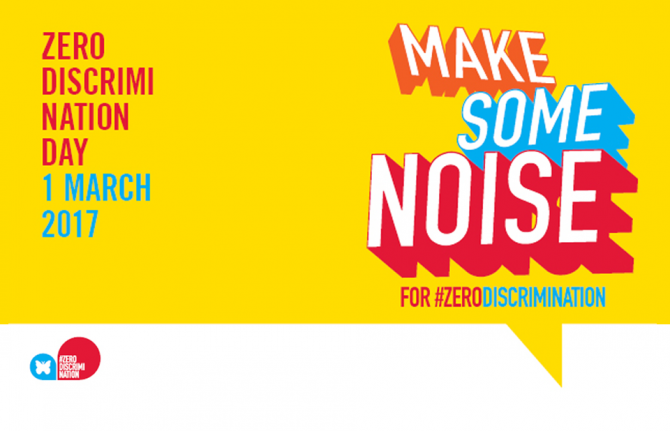
Press Release
UNAIDS urges everyone to make some noise for zero discrimination
23 February 2017 23 February 2017GENEVA, 23 February 2017—Everyone will have experienced discrimination of some kind during their lives; however, non-discrimination is a human right. Equally, states and individuals have a legal obligation not to discriminate. This year, on 1 March, Zero Discrimination Day, UNAIDS is urging people to make some noise around zero discrimination, to speak up and prevent discrimination from standing in the way of achieving ambitions, goals and dreams.
Discrimination has many forms, from racial or religious discrimination to discrimination based on gender, sexual orientation or age, and to bullying at school or at work. In only three out of 10 countries worldwide do equal numbers of girls and boys attend upper secondary school, and people living with disabilities are nearly three times more likely to be denied health care than other people.
“Everyone has the right to be treated with respect, to live free from discrimination, coercion and abuse,” said Michel Sidibé, Executive Director of UNAIDS. “Discrimination doesn’t just hurt individuals, it hurts everyone, whereas welcoming and embracing diversity in all its forms brings benefits for all.”
Zero discrimination is an integral part of UNAIDS’ vision and for this year’s Zero Discrimination Day UNAIDS is calling for zero discrimination in health-care settings. The right to health is a fundamental human right that includes access to affordable, timely and quality health-care services for all, yet discrimination remains widespread in health-care settings, creating a serious barrier to access to HIV services.
“Health-care settings should be safe and supportive environments. It is unacceptable that discrimination is inhibiting access to care today,” said Mr Sidibé. “Eliminating discrimination in health-care settings is critical, and we must demand that it become a reality.”
Data from 50 countries from the People Living with HIV Stigma Index show that one in eight people living with HIV report being denied health care. Around 60% of European Union/European Economic Area countries report that stigma and discrimination among health-care professionals remains a barrier to the provision of adequate HIV prevention services for men who have sex with men and people who inject drugs.
This year, UNAIDS is calling on everyone to make some noise for #zerodiscrimination. Zero Discrimination Day is an opportunity to highlight how everyone can be part of the transformation and take a stand for a fair and just society.
UNAIDS
The Joint United Nations Programme on HIV/AIDS (UNAIDS) leads and inspires the world to achieve its shared vision of zero new HIV infections, zero discrimination and zero AIDS-related deaths. UNAIDS unites the efforts of 11 UN organizations—UNHCR, UNICEF, WFP, UNDP, UNFPA, UNODC, UN Women, ILO, UNESCO, WHO and the World Bank—and works closely with global and national partners towards ending the AIDS epidemic by 2030 as part of the Sustainable Development Goals. Learn more at unaids.org and connect with us on Facebook, Twitter, Instagram and YouTube.


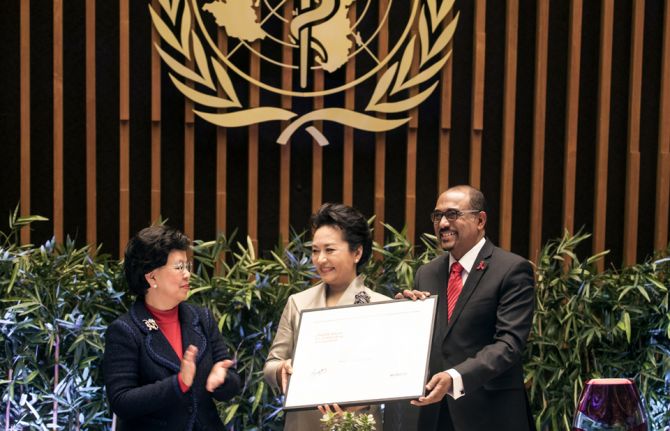
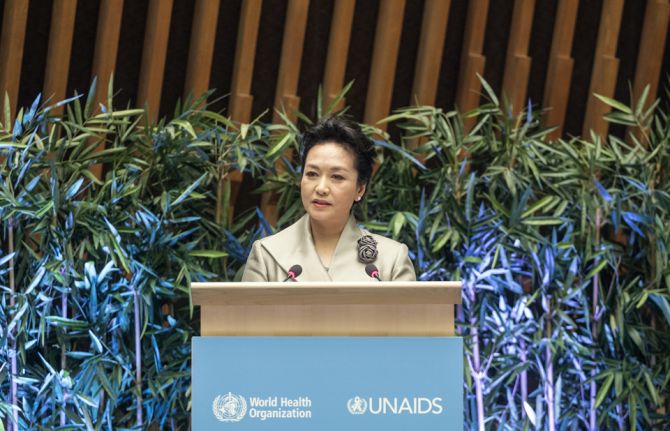
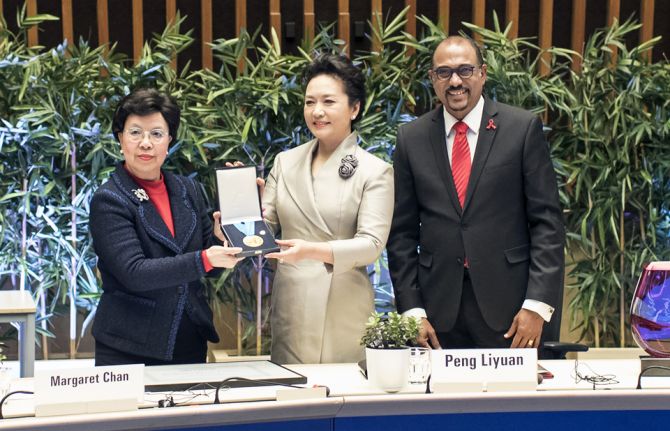
Press Release
UNAIDS presents the First Lady of China, Professor Peng Liyuan, with Award for Outstanding Achievement
18 January 2017 18 January 2017GENEVA, 18 January 2017—UNAIDS has presented Professor Peng Liyuan, the First Lady of China, with the UNAIDS Award for Outstanding Achievement in recognition of her remarkable contribution to the global response to HIV. The award was presented to Professor Peng by the Executive Director of UNAIDS, Michel Sidibé, at a special ceremony held in her honour organized by UNAIDS and the World Health Organization (WHO) in Geneva, Switzerland.
A renowned soprano singer, Professor Peng has been working on HIV and tuberculosis for more than 10 years and has advocated for a stronger response to the two diseases at major international events, including at meetings of the Group of Twenty and the United Nations General Assembly.
“This is a great honour and I am deeply humbled,” said Professor Peng on accepting the award. “A caring heart is our best weapon against AIDS—we can save lives if we take action. We must succeed and we will succeed.”
Professor Peng’s work to break down the barriers of stigma and discrimination is allowing more people to be reached with essential HIV services. Through her work with children and young people, in particular children orphaned by AIDS, she has enabled a broader understanding of how to support children living with HIV to live a healthy life with dignity and free from discrimination.
“Professor Peng has helped to open a national conversation around HIV in China that has spread empathy and compassion for people affected by HIV,” said Mr Sidibé. “She is a true champion for the most vulnerable, especially children affected by HIV, and has helped to create an environment for children to not just survive, but thrive.”
The work of Professor Peng and other prominent advocates has made an important contribution to the scale-up and improvement of services to prevent mother-to-child transmission of HIV around the world. These efforts have helped to more than halve the annual number of new HIV infections among children globally since 2010.
Progress has also been made in ensuring that children living with HIV have access to treatment. In 2005, less than 10% of children living with HIV had access to antiretroviral medicines, but heightened awareness and improvements in diagnostics and treatment availability have ensured that around 50% (870 000) of the 1.8 million children living with HIV had access to the life-saving medicines in 2015.
However, to reach the target countries committed to in the 2016 Political Declaration on Ending AIDS, the number of children accessing antiretroviral therapy needs to increase significantly, to 1.6 million children by 2018. “The world has made significant gains, but there is still much more to do and we need people like Professor Peng to continue speaking out and leading the way towards ending AIDS and tuberculosis,” said Mr Sidibé.
In 2015, Professor Peng collaborated with the Organisation of African First Ladies against HIV/AIDS in Johannesburg, South Africa, speaking out on key issues critical to ending AIDS by 2030. In 2011, Professor Peng was designated as a Goodwill Ambassador for Tuberculosis and HIV/AIDS by WHO. Her ambassadorship was renewed for a further term by WHO during the special ceremony.
UNAIDS
The Joint United Nations Programme on HIV/AIDS (UNAIDS) leads and inspires the world to achieve its shared vision of zero new HIV infections, zero discrimination and zero AIDS-related deaths. UNAIDS unites the efforts of 11 UN organizations—UNHCR, UNICEF, WFP, UNDP, UNFPA, UNODC, UN Women, ILO, UNESCO, WHO and the World Bank—and works closely with global and national partners towards ending the AIDS epidemic by 2030 as part of the Sustainable Development Goals. Learn more at unaids.org and connect with us on Facebook, Twitter, Instagram and YouTube.

Press Release
UNAIDS announces new donor commitments from the Nordic countries for 2017
20 December 2016 20 December 2016As 2016 draws to a close, UNAIDS welcomes new funding commitments from our partners in the Nordic region for 2017. The renewed political and financial support from the Nordic countries demonstrates their confidence in our performance and UNAIDS 2016-2021 Strategy – on the Fast-Track to end AIDS.
"These investments demonstrate the importance of our shared vision to end AIDS as a public health threat by 2030 as part of the Sustainable Development Goals,” said Michel Sidibé, UNAIDS Executive Director. “We welcome these new commitments, which come at a critical point in controlling the AIDS epidemic and will enable UNAIDS to focus on improving performance, delivering results and ensuring that no one is left behind by the global AIDS response."
The Swedish government will increase its annual core contribution to UNAIDS to SEK 230 million for 2017, to provide support to low- and middle-income countries to meet the goals of the 2016 United Nations Political Declaration on Ending AIDS.
“UNAIDS leadership is critical for our collective ambition of ending AIDS and to ensure zero discrimination of people living with HIV. Sweden’s political and financial support to UNAIDS was clearly demonstrated with the additional core support of SEK 50 million during 2016 to address the financial shortfall,” said Ulrika Modéer, State Secretary, Ministry of Foreign Affairs, Sweden. “We look forward to discussions on a sustainable and strengthened business model for UNAIDS in June 2017.”
Norway will increase its core contribution by NOK 10 million for 2017, resulting in a total of NOK 130 million for 2017.
“Norway has always been a strong and active supporter of the United Nations. The unique UNAIDS model has shown that the United Nations can deliver as one, under one budget and results framework,” said Laila Bokhari, State Secretary, Ministry of Foreign Affairs, Norway. “As a donor and a UNAIDS board member, Norway will continue to support the important mission of UNAIDS."
Denmark has strengthened its commitment to the AIDS response by announcing increased support to UNAIDS to DKK 30 million for 2017.
"UNAIDS is a longstanding and key strategic partner for Denmark in our efforts to end the AIDS epidemic by 2030. UNAIDS is a front-runner in promoting human rights and addressing stigma and discrimination in the area of HIV/AIDS, particularly relating to women and young girls,” said Ulla Tørnæs, Minister for Development Cooperation, Denmark. “I am very pleased that Denmark was able to provide an additional DKK 11 million to UNAIDS in 2016."
Denmark, Norway and Sweden also provided additional financial support to UNAIDS in 2016 as an emergency measure to address the budget deficit.
UNAIDS remains hopeful that more partners will follow the Nordic countries’ leadership in increasing their political and financial support for UNAIDS to reduce the currently projected funding gap for 2017 and ensure that the world is on the Fast-Track to ending AIDS as a public health threat by 2030.
UNAIDS
The Joint United Nations Programme on HIV/AIDS (UNAIDS) leads and inspires the world to achieve its shared vision of zero new HIV infections, zero discrimination and zero AIDS-related deaths. UNAIDS unites the efforts of 11 UN organizations—UNHCR, UNICEF, WFP, UNDP, UNFPA, UNODC, UN Women, ILO, UNESCO, WHO and the World Bank—and works closely with global and national partners towards ending the AIDS epidemic by 2030. Learn more at unaids.org and connect with us on Facebook, Twitter, Instagram and YouTube.

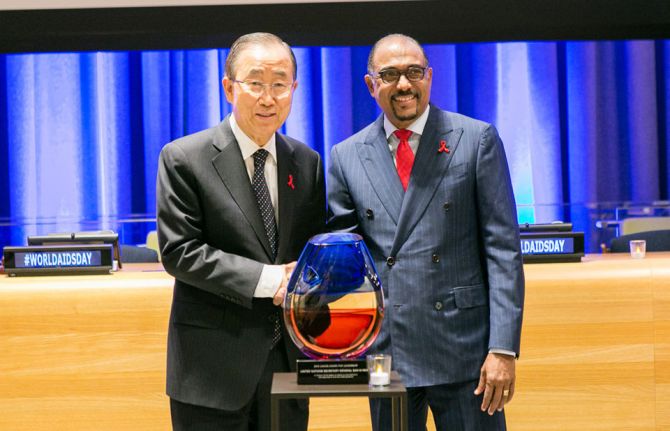
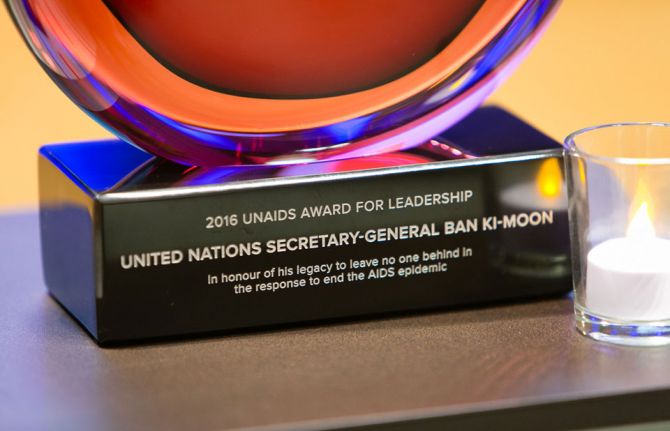
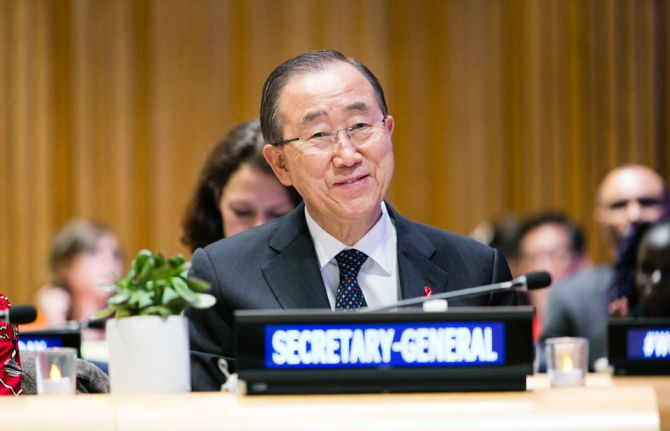
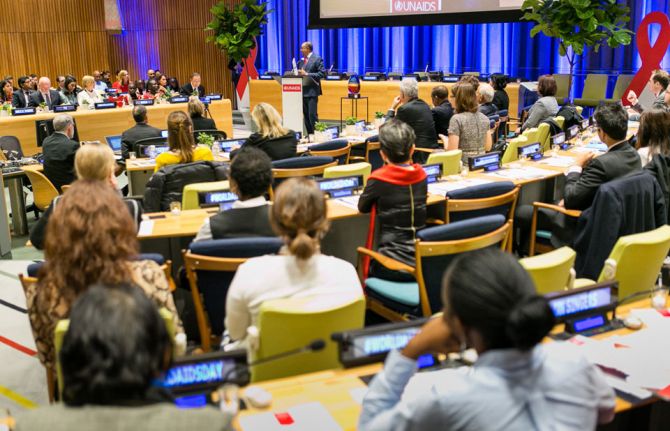
Press Release
UNAIDS presents UN Secretary-General Ban Ki-moon with leadership award for his commitment to the response to HIV
30 November 2016 30 November 2016UNAIDS recognizes Mr Ban for his outstanding efforts to ensure access to HIV services for all and for speaking out for the most marginalized in society.
NEW YORK/GENEVA, 30 November 2016—UNAIDS has honoured the United Nations Secretary-General, Ban Ki-moon, for his unfaltering commitment to ending the AIDS epidemic and for acting as a voice for the voiceless to ensure access to HIV services for the key populations most affected by HIV.
Under the leadership of the Secretary-General, the world reached the AIDS targets of Millennium Development Goal 6 and moved to end the AIDS epidemic by 2030 as part of the Sustainable Development Goals. Exceptional progress has also been made towards a shared vision of zero new HIV infections, zero discrimination and zero AIDS-related deaths.
“Together, we have worked for a world where more people than ever are on treatment. Half as many children are infected through mother-to-child transmission. And double the number of people have access to medicines. I am calling for action to get on the Fast-Track to our target of 30 million people on treatment by 2020,” said Mr Ban.
Mr Ban has consistently spoken out on behalf of gay men and other men who have sex with men, sex workers, people who inject drugs, prisoners and transgender people in order to ensure that they have access to life-saving HIV prevention and treatment services. He has been a longstanding supporter of an evidence-informed approach to the epidemic that puts people’s needs at the centre of the response to HIV.
“We are motivated to fight AIDS because we know that every child deserves care, every person deserves treatment and all vulnerable groups deserve protection from stigma and abuse,” said Mr Ban. “Tolerance and awareness help stop AIDS. Speaking out protects life.”
Mr Ban was presented with the Award for Leadership by the Executive Director of UNAIDS, Michel Sidibé, at a special World AIDS Day event held in his honour at the United Nations Headquarters in New York, United States of America, on the eve of World AIDS Day 2016.
“The progress the world has made in reducing the impact of HIV and expanding access to health for millions of people would not have been possible without the determined leadership of my friend, Ban Ki-moon,” said Mr Sidibé. “He has been consistent in his support for the most vulnerable in the world and remains a staunch human rights defender for the people most affected by the epidemic. His sense of service, commitment and compassion will continue to be a source of inspiration.”
Mr Ban has strongly supported the ambitious targets set by UNAIDS and its partners. In 2011, he participated in the launch of the Global Plan towards the elimination of new HIV infections among children by 2015 and keeping their mothers alive, which prioritized more than 20 countries that, in 2009, accounted for 90% of the global number of pregnant women living with HIV who were in need of services to prevent mother-to-child transmission. New HIV infections among children in the 21 countries most affected by the epidemic in sub-Saharan Africa decreased from 270 000 [230 000–330 000] in 2009 to 110 000 [78 000–150 000] in 2015. AIDS-related deaths among children in the priority countries fell by 53% in those six years as their access to treatment tripled.
In July 2015, Mr Ban participated in an event in the Ethiopian capital, Addis Ababa, to mark the achievement of the Millennium Development Goal 6 target of 15 million people gaining access to life-saving antiretroviral medicines. The “15 by 15” target set in 2011 and championed by Mr Ban was achieved several months ahead of schedule. Access to antiretroviral treatment continues to expand, to 18.2 million [16.1 million–19.0 million] people as of June 2016. Treatment access has grown six fold since Mr Ban took up office in 2007.
His bold and visionary leadership will continue to inspire the world to end the AIDS epidemic by 2030 within the framework of the Sustainable Development Goals.
UNAIDS LEADERSHIP AWARD
The UNAIDS Award for Leadership recognizes a person or an organization that has made a major and lasting contribution to restoring dignity and improving people’s lives. UNAIDS recognizes the key role leadership plays in creating an environment for positive social change and accelerating progress in the AIDS response and beyond.
The physical award was created by celebrated artist Jamie Harris and is made of infused glass. It has a blue orb to represent the United Nations delivering as one and a red flame to embody the global solidarity to end the AIDS epidemic.
UNAIDS
The Joint United Nations Programme on HIV/AIDS (UNAIDS) leads and inspires the world to achieve its shared vision of zero new HIV infections, zero discrimination and zero AIDS-related deaths. UNAIDS unites the efforts of 11 UN organizations—UNHCR, UNICEF, WFP, UNDP, UNFPA, UNODC, UN Women, ILO, UNESCO, WHO and the World Bank—and works closely with global and national partners towards ending the AIDS epidemic by 2030 as part of the Sustainable Development Goals. Learn more at unaids.org and connect with us on Facebook, Twitter, Instagram and YouTube.
Contact
UNAIDS New YorkSophie Barton-Knott
tel. +41 79 514 6896
bartonknotts@unaids.org
UNAIDS Geneva
Alasdair Reid
tel. +41 79 594 1923
reida@unaids.org
Press centre
Download the printable version (PDF)

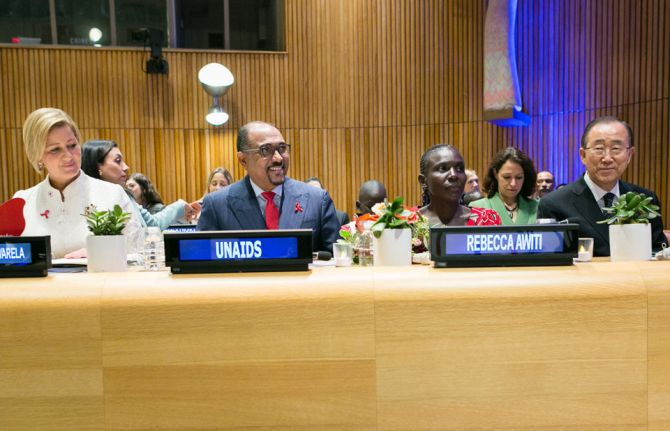
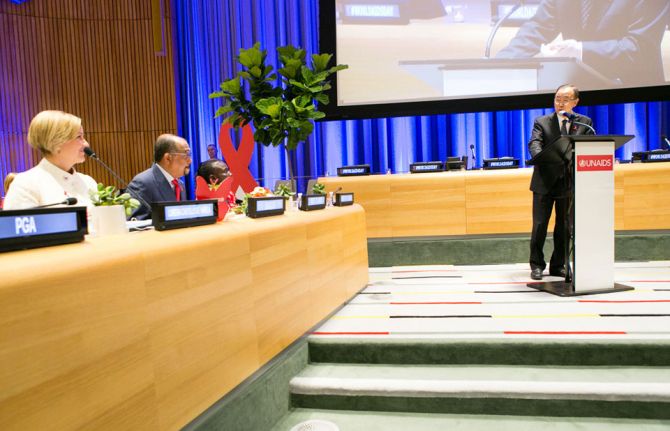
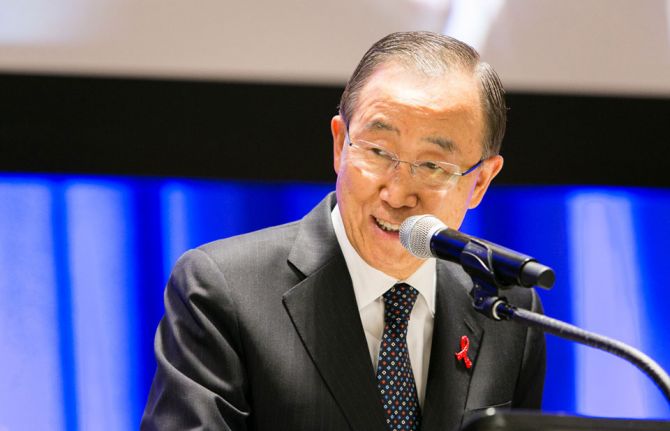

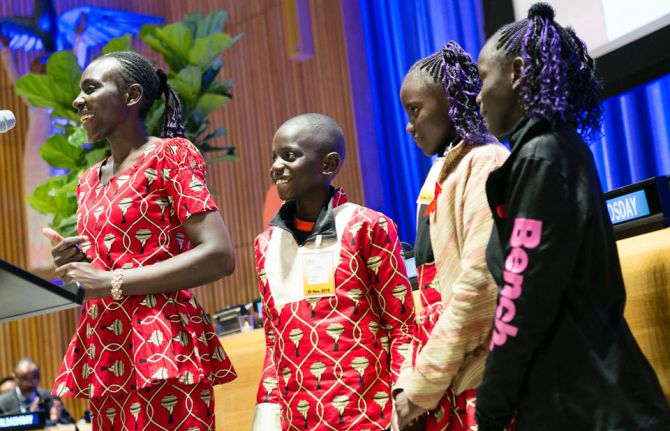

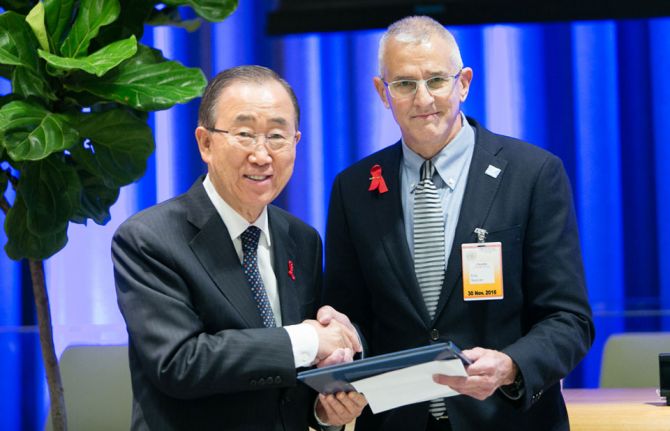
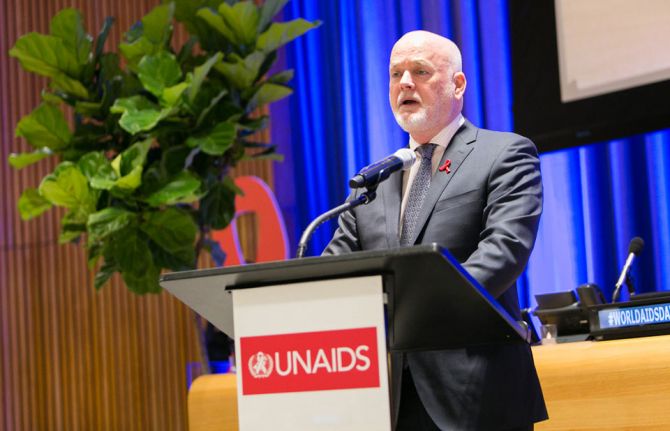
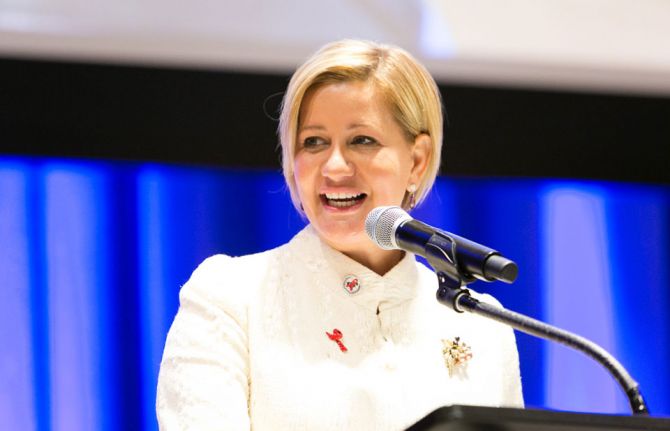

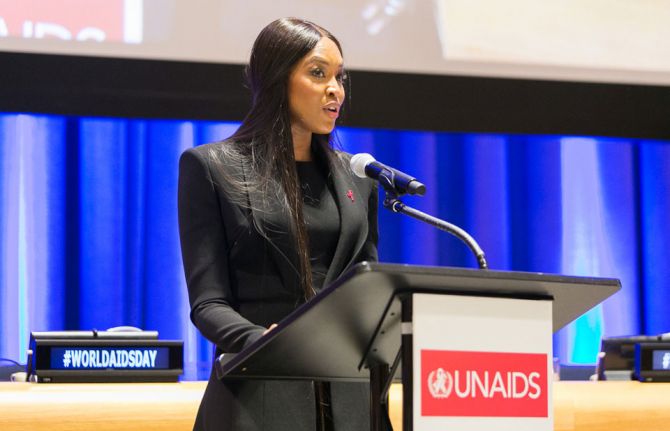
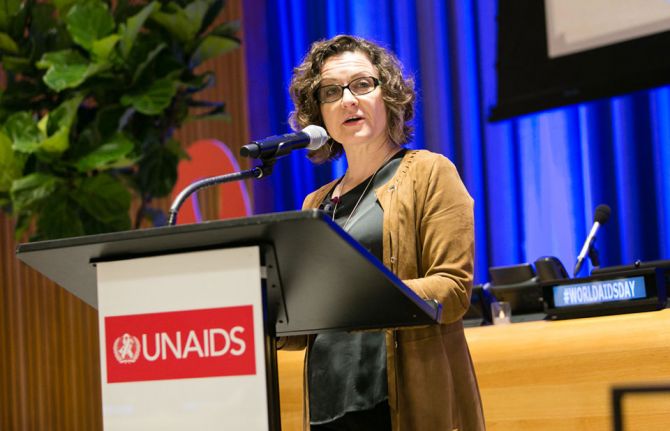

Press Release
UNAIDS hosts World AIDS Day event and honours the UN Secretary-General for his remarkable contributions to the AIDS response
30 November 2016 30 November 2016Speakers urge partners to move forward together to end the AIDS epidemic by 2030 as part of the Sustainable Development Goals
GENEVA/NEW YORK, 30 November 2016—On the eve of World AIDS Day, UNAIDS has hosted a special event at the United Nations Headquarters in New York, United States of America, to commemorate World AIDS Day. The event, Moving Forward Together: Leaving No One Behind, was also held to honour the leadership of the United Nations Secretary-General, Ban Ki-moon, and his remarkable contribution to the response to HIV in advance of his handover to the new Secretary-General, António Guterres, at the beginning of 2017.
Following a moment’s silence to remember the 35 million people who have lost their lives to AIDS, Michel Sidibé, Executive Director of UNAIDS, presented Mr Ban with the UNAIDS Award for Leadership for speaking out on behalf of, and his commitment to, the people most affected by HIV.
Accepting the award, Mr Ban said that he was proud to be an activist for the rights of lesbian, gay, bisexual, transgender and intersex people and spoke of his motivation. “We are motivated to fight AIDS because we know that every child deserves care, every person deserves treatment and all vulnerable groups deserve protection from stigma and abuse. Tolerance and awareness help stop AIDS. Speaking out protects life,” he said.
Mr Sidibé paid tribute to the Secretary-General and the exceptional achievements made in the AIDS response during his tenure. “Secretary-General Ban Ki-moon, you have been a true champion for people living with HIV. When you arrived only three million people were on HIV treatment. Our World AIDS Day report shows that more than 18 million are now on treatment. This isn’t just about numbers, but the very lives of people. You have shown through these years that people’s dignity is central to your agenda,” he said.
Since Mr Ban assumed office as United Nations Secretary-General in January 2007, the number of people living with HIV accessing life-saving antiretroviral therapy has increased from 2.9 million at the end of 2006, to 18.2 million [16.1 million–19.0 million] in June 2016. The number of people who died from AIDS-related illnesses has halved, from 2 million in 2006 to 1.1 million in 2015, and the number of new HIV infections among children has been reduced by two thirds, from 430 000 in 2006 to 150 000 in 2015.
During the event, Mr Ban was reacquainted with Rebecca Awiti, a woman living with HIV who met the Secretary-General in 2011 during an official visit to Kenya, where he launched The Global Plan towards the elimination of new HIV infections among children and keeping their mothers alive. Ms Awiti is the mother of triplets, born free from HIV thanks to antiretroviral medicines. “You brought hope to me, my children and my children’s children that an AIDS-free generation is possible in our lifetime,” she said.
One of the founders of the global HIV treatment access movement, Eric Sawyer, praised the Secretary-General for his commitment to zero discrimination. “Mr Secretary-General, I thank you as a long-term survivor of HIV and as a long-time member of UN Plus and UN Cares, and a member of the Free and Equal campaign, for your leadership, for your compassion and for your commitment to the AIDS response, and for your commitment to equality and human rights for all,” he said.
As a special guest at the event, the First Lady of Panama, Lorena Castillo de Varela, who is also UNAIDS Special Ambassador for AIDS in Latin America, stressed the importance of breaking down the stigma still surrounding HIV and standing firm on zero discrimination. “We must all carry the torch for the Secretary-General and, as leaders, fight discrimination every day of our lives,” she said. “We must celebrate the diversity that unites us, and promote solidarity, respect, inclusion and peace.”
Kenneth Cole, amfAR Chair and a leading fashion designer, warned of a growing population that is disengaged and desensitized to the virus and said it was a critical time to coordinate and Fast-Track the effort to end AIDS. “We can contain and reverse the AIDS epidemic through a coordinated response. I strongly believe we can and must and will make AIDS history,” he said.
The President of the United Nations General Assembly, Peter Thomson, called on the world to do more and reach the clear time-bound targets set by Member States in the 2016 Political Declaration on Ending AIDS. “On this World AIDS Day, we honour those who have passed away by committing to end the AIDS epidemic, achieve the Sustainable Development Goals and build a healthy, safe, peaceful and sustainable future for us all,” he said.
Model, actress and philanthropist Naomi Campbell spoke of the triple threat facing young women and girls of not knowing their HIV status, not accessing life-saving treatment and not being empowered to protect themselves from HIV. “Today, I stand in solidarity with the millions of young women and adolescent girls growing up in a world where they are at risk of HIV,” she said. “I want to make a difference—you can count on me to do what I can to help end AIDS.”
Deputy Executive Director of the United Nations Population Fund, Laura Londén, underscored the importance of working as one to Fast-Track the response to HIV. “We can only reach the goal of ending the AIDS epidemic by 2030 if we are serious about HIV prevention. We need to end the isolation and fear that key populations face every day,” she said.
The event culminated with an inspirational and uplifting performance by the United Nations Choir, which performed Mae, a Japanese song about moving forward.
|
Global summary of the AIDS epidemic in 2015/2016* |
||
|
Number of people living with HIV
|
Total |
36.7 million [34.0 million–39.8 million] |
|
Adults |
34.9 million [32.4 million–37.9 million] |
|
|
Women |
17.8 million [16.4 million–19.4 million] |
|
|
Children (<15 years) |
1.8 million [1.5 million–2.0 million] |
|
|
Number of people newly infected with HIV |
Total |
2.1 million [1.8 million–2.4 million] |
|
Adults |
1.9 million [1.7 million–2.2 million] |
|
|
Children (<15 years) |
150 000 [110 000–190 000] |
|
|
AIDS-related deaths |
Total |
1.1 million [940 000–1.3 million] |
|
Adults |
1.0 million [840 000–1.2 million] |
|
|
Children (<15 years) |
110 000 [84 000–130 000] |
|
|
Number of people on HIV treatment |
Total |
*18.2 million [16.1 million–19.0 million], June 2016 |
UNAIDS
The Joint United Nations Programme on HIV/AIDS (UNAIDS) leads and inspires the world to achieve its shared vision of zero new HIV infections, zero discrimination and zero AIDS-related deaths. UNAIDS unites the efforts of 11 UN organizations—UNHCR, UNICEF, WFP, UNDP, UNFPA, UNODC, UN Women, ILO, UNESCO, WHO and the World Bank—and works closely with global and national partners towards ending the AIDS epidemic by 2030 as part of the Sustainable Development Goals. Learn more at unaids.org and connect with us on Facebook, Twitter, Instagram and YouTube.
Contact
UNAIDS New YorkSophie Barton-Knott
tel. +41 79 514 6896
bartonknotts@unaids.org
UNAIDS Geneva
Alasdair Reid
tel. +41 79 594 1923
reida@unaids.org
Press centre
Download the printable version (PDF)
